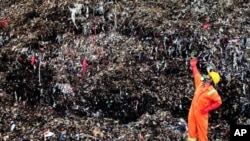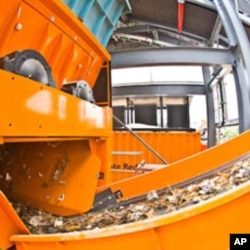Each year Indonesia adds around 2 billion tons of greenhouse gases to the atmosphere - making it the world's third largest carbon emitter. Industry accounts for less than 10 percent of that amount, but businesses here say going green has benefits beyond environmental sustainability.
Some multinational and Indonesian companies hope to boost revenues from the sale of carbon credits. Others say energy efficiency measures can raise profits while helping them meet commitments on social and environmental improvements.
Alternative fuels made from waste products
Oil and gas companies here are working to capture excess gas released during production and reuse it for energy.
There are clean-energy projects that run partly on biogas or hydropower. PT Indo Tirta Suaka, a pig farm owned by Indonesia's biggest conglomerate, is taking methane released from manure and turning it into power.
Cement industry giants Indocement and Holcim cut their coal use by firing kilns with alternative fuels made from plants and waste.
Vincent Aloysius, the country manager at Holcim's waste processing facility, Geocycle, explains the various types of waste the company receives.
"These are off-cuts from the electronics industry - they make the printed circuit boards - these are the off-cuts, like a plastic kind of material," he says, "And there is the oil sludge materials, and municipal solid waste that has been composted. That's where the smell is coming from."
The materials go through a shredder, then they are used as fuel for the plant's two giant cement kilns.
Geocycle takes in waste from more than 100 companies - ranging from garment manufacturers to candy producers.
Aloysius says Geocycle hopes to take in more industrial waste that is sometimes shipped to other countries for processing at a huge cost to industry. "The cost of pollution or dealing or living with pollution is much, much more than the cost of pollution prevention. It might seem that it's money spent on waste for example, but if we pollute our rivers, our beaches and our hills and valleys, then the potential for a country like Indonesia - on tourism for example - then the damage can be huge," Aloysius states.
Indocement's alternative fuel project reduces emissions by using fuel made from rice husks, sawdust and used tires. Both companies have been certified under the United Nation's Framework Convention on Climate Change.
Earning credit by reducing greenhouse gas emissions
Under that agreement, projects that reduce greenhouse gas emissions can earn credits they can sell to industrialized nations that have binding emissions targets under the Kyoto Protocol.
Scientists believe greenhouse gases contribute to global warming. Many of them, including carbon dioxide, are produced by burning fuels such as coal and oil.
The U.N. framework presents some problems for companies because of its complex registration procedures and lengthy approval times.
Indonesia has 48 registered projects compared with nearly 1,000 in China and more than 500 in India.
Some business consulting companies here say the government should approve more corporate projects that reduce emissions, although their individual effect is small. Geocycle, for instance, processes an average of 220,000 tons of waste a year, but that generates only enough energy to cut its coal use by 15 percent.
Agnes Safford is managing director of Green Works Asia, a consulting firm that helps companies reduce their carbon emissions. She says Indonesia still trails behind some countries on reducing emissions, partly because it lacks stringent environmental protection laws.
But, she says, even without legal requirements, many companies find that cost savings are enough reason to implement energy efficiency measures.
"They don't have all the safety regulations set out and they can kind of cut corners here and there. But at the end of the day it really gets down to cost savings, and they're all quite cost efficient," Safford said.
She says even small changes can boost profit, and it is just a matter of showing business owners the savings and convincing them that consumers are paying attention to their environmental commitment.









